Abstract
The magnitude and role of dark CO2 fixation were examined in nodules of intact soybean plants (Harosoy 63 × Rhizobium japonicum strain USDA 16). The estimated rate of nodule dark CO2 fixation, based on a 2 minute pulse-feed with 14CO2 under saturating conditions, was 102 micromoles per gram dry weight per hour. This was equivalent to 14% of net nodule respiration. Only 18% of this CO2 fixation was estimated to be required for organic and amino acid synthesis for growth and export processes. The major portion (75-92%) of fixed label was released as CO2 within 60 minutes. The labeling pattern during pulse-chase experiments was consistent with CO2 fixation by phosphoenolpyruvate carboxylase. During the chase, the greatest loss of label occurred in organic acids. Exposure of nodulated roots to Ar:O2 (80:20) did not affect dark CO2 fixation, while exposure to O2:CO2 (95:5) resulted in 54% inhibition. From these results, it was concluded that at least 66% of dark CO2 fixation in soybean may be involved with the production of organic acids, which when oxidized would be capable of providing at least 48% of the requirement for ATP equivalents to support nitrogenase activity.
Full text
PDF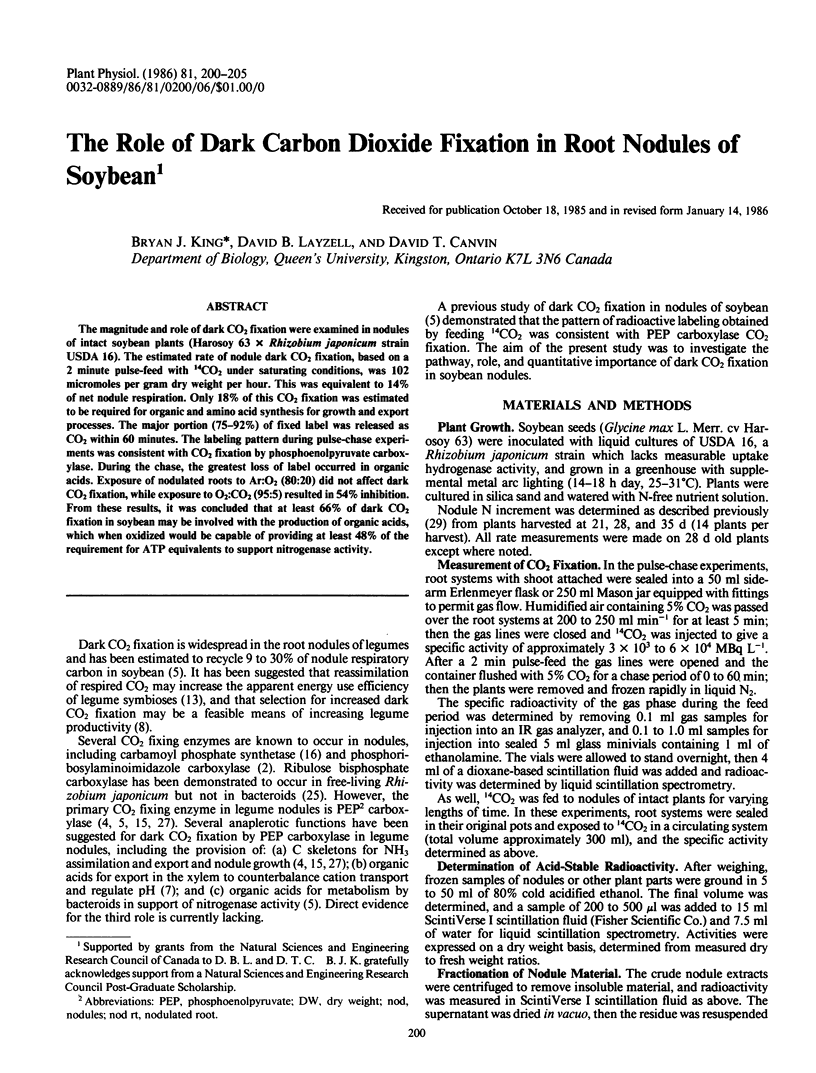
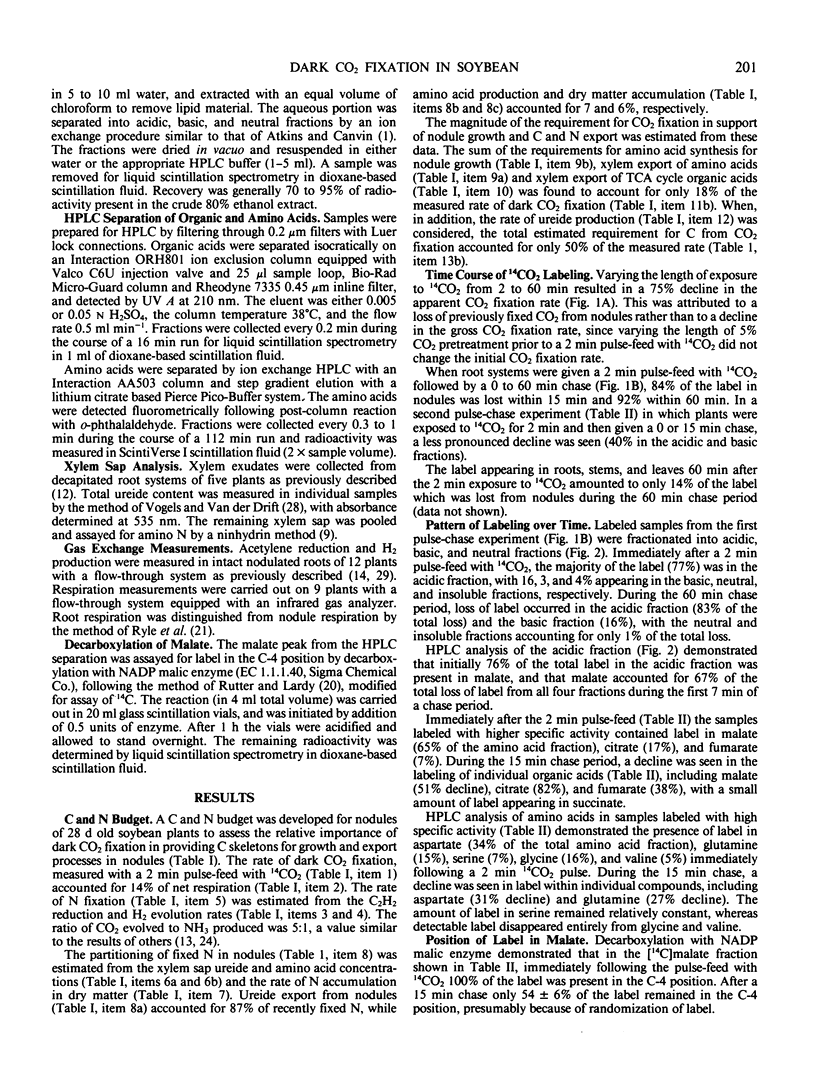
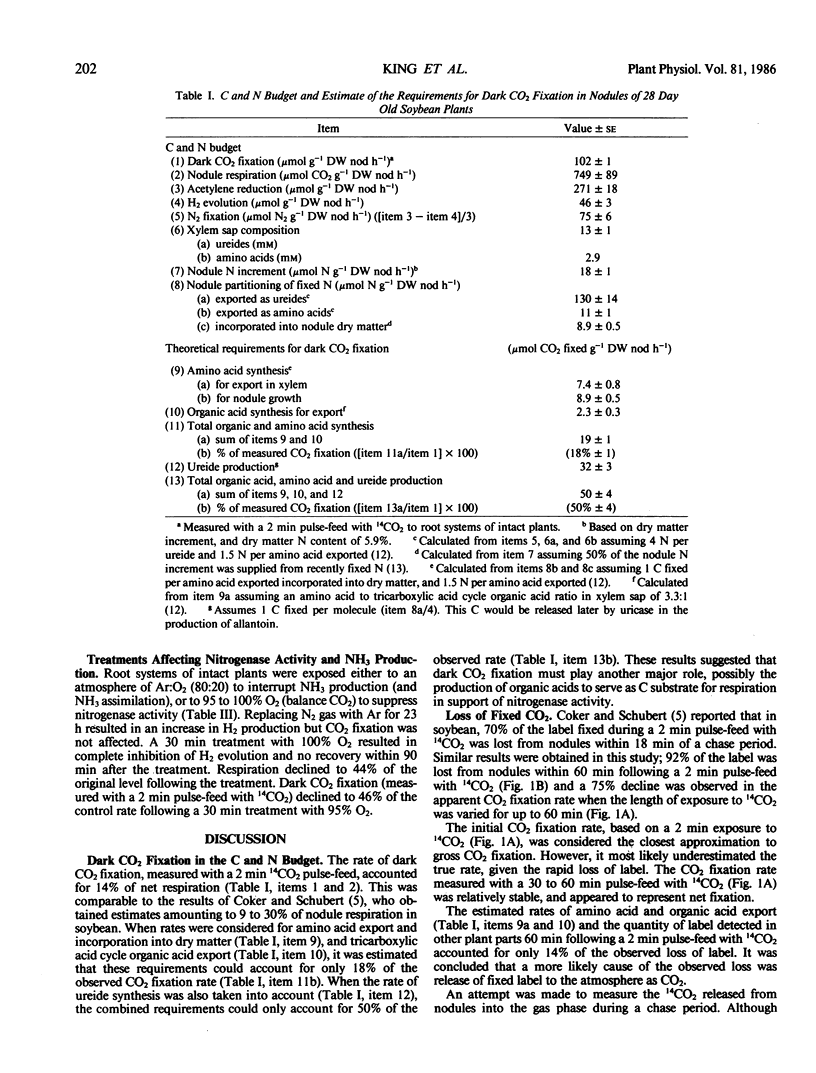
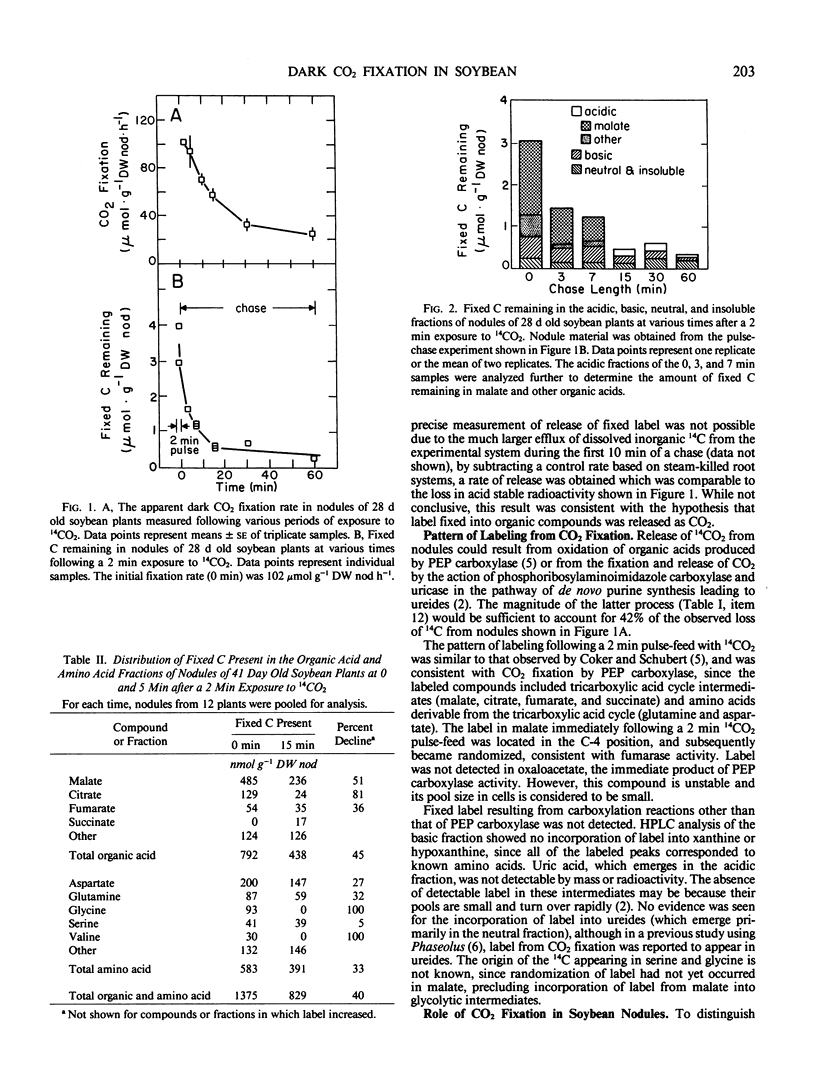
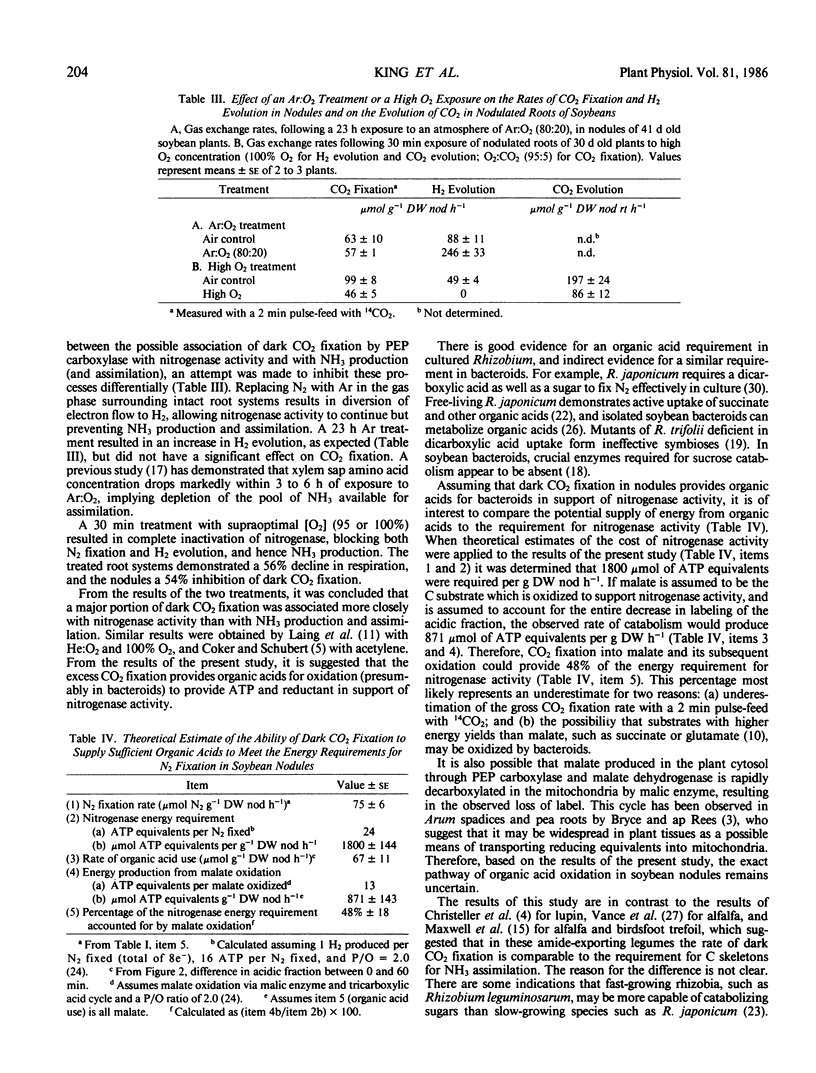
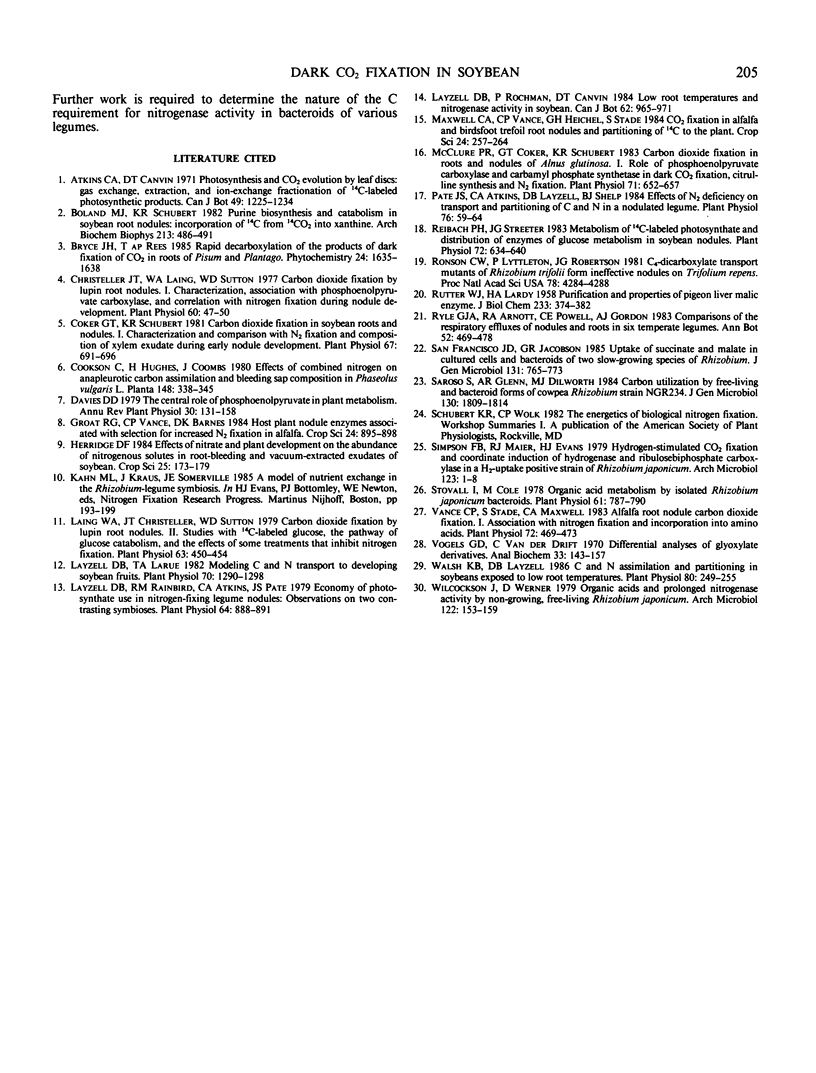
Selected References
These references are in PubMed. This may not be the complete list of references from this article.
- Boland M. J., Schubert K. R. Purine biosynthesis and catabolism in soybean root nodules: incorporation of 14C from 14CO2 into xanthine. Arch Biochem Biophys. 1982 Feb;213(2):486–491. doi: 10.1016/0003-9861(82)90574-4. [DOI] [PubMed] [Google Scholar]
- Christeller J. T., Laing W. A., Sutton W. D. Carbon Dioxide Fixation by Lupin Root Nodules: I. Characterization, Association with Phosphoenolpyruvate Carboxylase, and Correlation with Nitrogen Fixation during Nodule Development. Plant Physiol. 1977 Jul;60(1):47–50. doi: 10.1104/pp.60.1.47. [DOI] [PMC free article] [PubMed] [Google Scholar]
- Coker G. T., Schubert K. R. Carbon Dioxide Fixation in Soybean Roots and Nodules: I. CHARACTERIZATION AND COMPARISON WITH N(2) FIXATION AND COMPOSITION OF XYLEM EXUDATE DURING EARLY NODULE DEVELOPMENT. Plant Physiol. 1981 Apr;67(4):691–696. doi: 10.1104/pp.67.4.691. [DOI] [PMC free article] [PubMed] [Google Scholar]
- Laing W. A., Christeller J. T., Sutton W. D. Carbon Dioxide Fixation by Lupin Root Nodules: II. Studies with C-labeled Glucose, the Pathway of Glucose Catabolism, and the Effects of Some Treatments That Inhibit Nitrogen Fixation. Plant Physiol. 1979 Mar;63(3):450–454. doi: 10.1104/pp.63.3.450. [DOI] [PMC free article] [PubMed] [Google Scholar]
- Layzell D. B., Larue T. A. Modeling C and N transport to developing soybean fruits. Plant Physiol. 1982 Nov;70(5):1290–1298. doi: 10.1104/pp.70.5.1290. [DOI] [PMC free article] [PubMed] [Google Scholar]
- Layzell D. B., Rainbird R. M., Atkins C. A., Pate J. S. Economy of Photosynthate Use in Nitrogen-fixing Legume Nodules: Observations on Two Contrasting Symbioses. Plant Physiol. 1979 Nov;64(5):888–891. doi: 10.1104/pp.64.5.888. [DOI] [PMC free article] [PubMed] [Google Scholar]
- McClure P. R., Coker G. T., Schubert K. R. Carbon Dioxide Fixation in Roots and Nodules of Alnus glutinosa: I. Role of Phosphoenolpyruvate Carboxylase and Carbamyl Phosphate Synthetase in Dark CO(2) Fixation, Citrulline Synthesis, and N(2) Fixation. Plant Physiol. 1983 Mar;71(3):652–657. doi: 10.1104/pp.71.3.652. [DOI] [PMC free article] [PubMed] [Google Scholar]
- Pate J. S., Atkins C. A., Layzell D. B., Shelp B. J. Effects of n(2) deficiency on transport and partitioning of C and N in a nodulated legume. Plant Physiol. 1984 Sep;76(1):59–64. doi: 10.1104/pp.76.1.59. [DOI] [PMC free article] [PubMed] [Google Scholar]
- RUTTER W. J., LARDY H. A. Purification and properties of pigeon liver malic enzyme. J Biol Chem. 1958 Aug;233(2):374–382. [PubMed] [Google Scholar]
- Reibach P. H., Streeter J. G. Metabolism of C-labeled photosynthate and distribution of enzymes of glucose metabolism in soybean nodules. Plant Physiol. 1983 Jul;72(3):634–640. doi: 10.1104/pp.72.3.634. [DOI] [PMC free article] [PubMed] [Google Scholar]
- Ronson C. W., Lyttleton P., Robertson J. G. C(4)-dicarboxylate transport mutants of Rhizobium trifolii form ineffective nodules on Trifolium repens. Proc Natl Acad Sci U S A. 1981 Jul;78(7):4284–4288. doi: 10.1073/pnas.78.7.4284. [DOI] [PMC free article] [PubMed] [Google Scholar]
- Stovall I., Cole M. Organic Acid Metabolism by Isolated Rhizobium japonicum Bacteroids. Plant Physiol. 1978 May;61(5):787–790. doi: 10.1104/pp.61.5.787. [DOI] [PMC free article] [PubMed] [Google Scholar]
- Vance C. P., Stade S., Maxwell C. A. Alfalfa root nodule carbon dioxide fixation : I. Association with nitrogen fixation and incorporation into amino acids. Plant Physiol. 1983 Jun;72(2):469–473. doi: 10.1104/pp.72.2.469. [DOI] [PMC free article] [PubMed] [Google Scholar]
- Vogels G. D., Van der Drift C. Differential analyses of glyoxylate derivatives. Anal Biochem. 1970 Jan;33(1):143–157. doi: 10.1016/0003-2697(70)90448-3. [DOI] [PubMed] [Google Scholar]
- Walsh K. B., Layzell D. B. Carbon and nitrogen assimilation and partitioning in soybeans exposed to low root temperatures. Plant Physiol. 1986 Jan;80(1):249–255. doi: 10.1104/pp.80.1.249. [DOI] [PMC free article] [PubMed] [Google Scholar]


